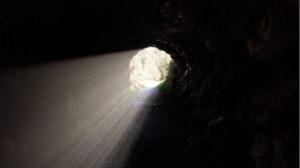Desert Metals swings around for another tilt at Dingo Pass

Desert Metals says the best is yet to come from Dingo Pass, as it swings round for another crack at intersecting the massive sulphides it believes are still down there. Pic via Getty Images.
Down-hole electromagnetic exploration on five holes drilled by Desert Metals have indicated that previously identified very high conductance bodies have yet to be intersected by drilling.
While holes DRC003 to DRC007 at Dingo Pass intersected metamorphosed mafic intrusions with traces of disseminated copper and nickel bearing sulphides, these were not present in sufficient quantities to explain the anomalies.
Modelling of DHEM data from these holes confirms the presence of the very high conductance bodies (up to 30,000 Siemens), which were first defined by airborne and then ground EM surveys, and suggests that they are off-hole from the initial reverse circulation drilling.
Desert Metals (ASX:DM1) has mobilised a RC rig to site and will start drilling later this week in a bid to test the bodies.
Diamond drilling is scheduled to begin later this month.
Modelled conductance bodies
From its initial drilling, the company has inferred that the targeted host intrusions were deformed and metamorphosed.
In other nickel provinces where this is the case, such as the Thomson Belt in Manitoba, Canada, the sulphides are often reworked into fold hinges and other structurally complex positions.
This makes their associated conductance difficult to model and would explain the relative lack of success in intersecting the targeted conductors on the first pass.
This article was developed in collaboration with Desert Metals, a Stockhead advertiser at the time of publishing.
This article does not constitute financial product advice. You should consider obtaining independent advice before making any financial decisions.

UNLOCK INSIGHTS
Discover the untold stories of emerging ASX stocks.
Daily news and expert analysis, it's free to subscribe.
By proceeding, you confirm you understand that we handle personal information in accordance with our Privacy Policy.








